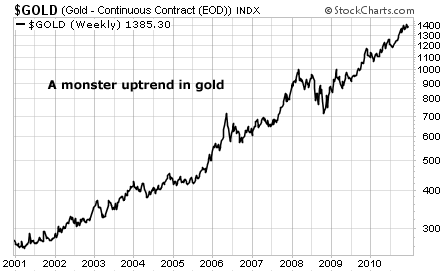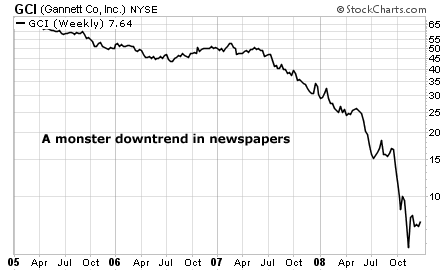Martin Zweig is one of the greatest analysts and traders who ever looked at a stock quote.
He achieved fame and fortune in the 1970s and '80s with his Zweig Forecast market advisory. He's also a successful money manager who bought a New
York penthouse apartment in 1999 for $21.5 million. The place cost an
astounding $40,000 a month in maintenance fees. The guy knows how to
move money from the market's account to his.
Zweig's book, Winning on Wall Street, is one of the all-time greatest books ever written on trading. Located in the middle of Zweig's book is this timeless quote:
"I can't emphasize enough the importance of staying with the
trend in the market, being in gear with the tape, and not fighting the
major movements. Fighting the tape is an invitation to disaster."
(In the early days of Wall Street, traders received updates by a
machine that printed out prices on a roll of ticker tape. Even today,
with the ticker tape machines long gone, traders still call market
action "the tape.")
What is Martin getting at?
Hundreds of thousands of traders have blown up their trading
accounts by trading AGAINST uptrends and by trading AGAINST downtrends.
Take a look at the uptrend in gold prices from 2001 through 2010:
In gold's case, you could call the uptrend a "series of higher
highs and higher lows." Each rally in gold takes it higher than the
previous high... and each decline in gold ends a bit higher than the
previous decline.
Let's also be sure of what a trend of lower prices, called a
downtrend, looks like. Below is the downtrend in the share price of
newspaper giant Gannett (publisher of USA Today) from 2005 through 2008:
In Gannett's case, you could call the downtrend a "series of lower
highs and lower lows." Each rally in Gannett's share price ends a bit
lower than the previous rally... and each decline takes Gannett a bit
lower than the previous low.
Everyone who bet against gold and everyone who bet on Gannett was
sure he knew something the market didn't... that maybe an uptrend was
due to end in a big crash... or that a downtrend was due to end in a big
rally. So they bet on the trends ending.
This is called "fighting the tape." And as Martin notes, it is an
invitation to disaster... for the simple reason that trends tend to last
longer than anyone expects them to. Or as legendary investor Jim Rogers
reminds us:
"Markets often rise higher than you think is possible, and fall lower than you can possibly imagine."
This is why you never want to bet against a major uptrend (like the
one in gold we just showed you) or a major downtrend (like the one in
Gannett).
Trends can last a long time... and you must either trade with the trend, or step aside. But never stubbornly trade against it.
We rarely recommend making trades based on an asset's chart alone.
We recommend you know how cheap or expensive an asset is... and we
recommend knowing if investor sentiment for that asset is skewed toward
pessimism or optimism.
But from a general standpoint, you want to be long uptrends and short downtrends.
And unless you're trading for lightning-fast moves of just a few
days or weeks, never short a major uptrend and never buy a major
downtrend. Or in Martin Zweig's words, "never fight the tape."
Good trading,
Brian Hunt





